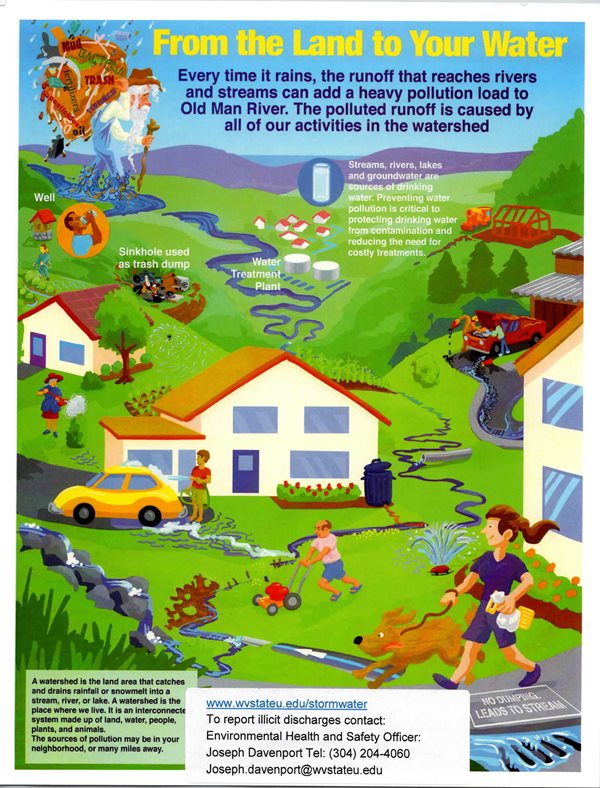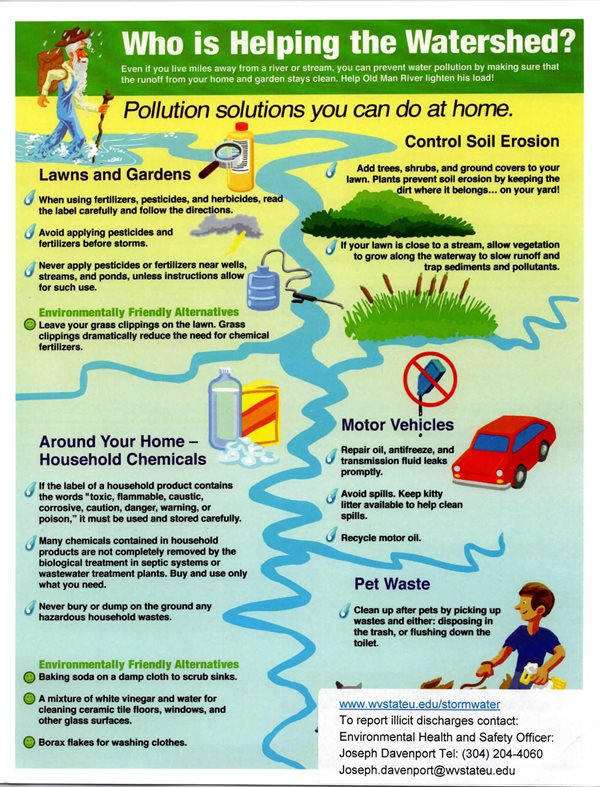

Stormwater Management Program Overview
2016 Stormwater Management Plan
Polluted stormwater runoff is often transported to municipal separate storm sewer systems (MS4) and ultimately discharged into local rivers and streams without treatment. With the passage of the 1972 Clean Water Act, the quality of our Nation’s quality of waters has gotten better, however, close to 40 percent of all waters are still too polluted and do not meet the water quality standards.
In 1990, EPA promulgated rules establishing Phase I of the National Pollutant Discharge Elimination System (NPDES) stormwater program. The Phase I program for MS4s requires operators of “medium” and “large” MS4s, that is, those that generally serve populations of 100,000 or greater, to implement a stormwater management program as a means to control polluted discharges from these MS4s. The Stormwater Phase II Rule extends coverage of the NPDES stormwater program to certain “small” MS4s but takes a slightly different approach to how the stormwater management program is developed and implemented.
What is Phase II Small MS4?
A small MS4 is any MS4 not already covered by the Phase I program as a medium or large MS4. The Phase II Rule automatically covers on a nationwide basis all small MS4s located in “urbanized areas” (UAs) as defined by the Bureau of the Census (unless waived by the NPDES permitting authority), and on a case-by-case basis those small MS4’s located outside of UAs that the NPDES permitting authority designates. For more information on Phase II small MS4 coverage, see Fact Sheets 2.1 and 2.2.
What Are The Phase II Small MS4 Program Requirements?
Operators of regulated small MS4s are required to design their program to: Reduce the discharge of pollutants to the “maximum extent practicable” (MEP), Protect water quality, and Satisfy to appropriate water quality requirements of the Clean Water Act.
Implementation of the MEP standard will typically require the development and implementation of BMP’s and the achievement of measurable goals to satisy each of the six minimum control measures
The Phase II rule defines a small MS4 stormwater management program as a program comprising of six elements that, when implemented in concert, are expected to result in significant reduction of pollutants discharged into receiving waterbodies.
The Phase II Rule defines small MS4 stormwater management programs as a program comprising of six elements that when implemented in concert, are expected to result in significant reductions of pollutants discharged into receiving waterbodies. The Stormwater Phase II Final Rule is the next step in EPA’s effort to preserve, protect, and improve the Nation’s water resources from polluted stormwater runoff, and is intended to further reduce adverse impacts on water quality and aquatic habitats by reducing the quantity of pollutants that stormwater picks up and carriers into storm sewer systems during storm events. Pollutants such as oil and grease on roadways, pesticides from lawns, sediment from construction sites, and even carelessly discard trash like cigarette butts, paper wrappers, and plastic bottles all damage the water quality and leads to the following such as discouragement of recreational use, causing drinking water to become contaminated, and causes hazardous and life threatening to habitats for fish, wildlife and other aquatic organisms.
West Virginia State University has an approved MS4 permit and is currently taking the appropriate steps to reduce stormwater pollution. West Virginia State University is currently implementing a stormwater management program or SWMP, created to reduce the discharge of pollutants from its small municipal separate storm sewer system to the maximum extent practicable (MPE), to protect water quality and satisfy the appropriate requirements of the Clean Water Act (CWA). The MS4 program elements are:
- Public Education and Outreach
- Public Participation/involvement
- Illicit discharge Detection and Elimination
- Construction Site Runoff Control
- Post-Construction Runoff Control
- Pollution Prevention/Good Housekeeping
WVSU MS4 – BMP Spreadsheet
West Virginia State University’s Stormwater Management Program will not succeed without the support of the students, faculty, staff and visitors. Visit our website often for updates and events. Participate in campus organizations, provide feedback about the programs implementation and direction, review stormwater material and let’s all help improve the environment.
Illicit Discharges
Stormwater regulations define an “illicit discharge” as “any discharge to a municipal separate storm sewer that is not composed entirely of stormwater” (except discharges resulting from fire fighting activities)..There are three types of discharge frequencies that help categorize a possible illicit discharge. These three type of frequencies are:
- Continuous-discharges occurring most or all of the time, which are easier for us to recognize but produce the largest amount of pollutant loads.
- Intermittent-discharges occurring over a shorter period of time. These discharges are harder to detect, but still represent a serious water quality issue.
- Transitory-discharges occurring rarely, usually due to an industrial/accidental spill, ruptured tank, sewer break or illegal dumping. These discharges are extremely hard to detect but can have severe water quality impacts.
Potential illicit discharges include but not limited to:
- Sewage
- Wash water
- Liquid wastes
- Broken tap water lines
- Landscape irrigation
- Groundwater
Helpful Links
WVSU MS4 General Permit
MS4 Annual Reports
US Environmental Protection Agency
WV Department of Environmental Protection
Stormwater Surveys
Report Illicit Discharges
WVSU Stormwater Maps
Contact Us
- Daniel Brown
- Director Facilities
- Phone: 681-710-5696
- Email: daniel.brown@wvstateu.edu